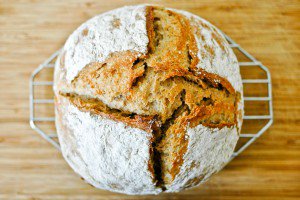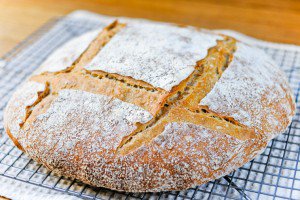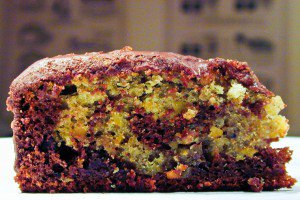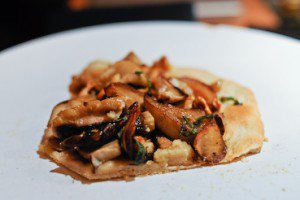I have been wanting to make my own crumpets for about eight years. I can tell you this because that’s when I remember placing, in my bulging clipping file, a mauve scrap of paper on which I’d copied a crumpet recipe from one of the ladies’ magazines my grandmother used to subscribe to.
But the recipe involved yeast, and back then I hadn’t yet conquered my fear of it, so the recipe hibernated in the “miscellaneous” section for years, until it eventually got the ax during a perhaps overzealous pruning campaign.
The project resurfaced in my mind a few months ago, when I learned from the King Arthur Flour website that you could make sourdough crumpets with natural starter.
Now I can count on fantastic crumpets every time: nicely bubbly at the top, to catch the drippings of whatever you spread them with, crisp around the edges, and lightly doughy on the inside, with a subtle tang to the palate.
A thrifty recipe for sourdough crumpets
Better yet, the recipe is the kind that every natural starter enthusiast dreams of: one that offers to use up the excess starter that the natural feeding cycle leaves you with*. All you need to do is store that extra starter in a container in the fridge — I’ve recycled an empty tub of yogurt for that purpose — until it amounts to roughly a cup (270 grams), which, in my case, takes about three feedings. You mix that with a bit of sugar, salt, and baking soda, and cook the foamy batter like pancakes in a skillet.
It took me a couple of tries to get them right — I had to figure out how hot the skillet needed to be, how much of the batter I should use for each crumpet, and that the crumpet rings needed to be well greased and well preheated to prevent sticking — but now I can count on fantastic sourdough crumpets every time: nicely bubbly at the top, to catch the drippings of whatever you spread them with, crisp around the edges, and lightly doughy on the inside, with a subtle tang to the palate.
I decided to equip myself with proper crumpet rings, which produce straight sides and a neat, stackable shape, but you can do without, or use, as I’ve seen suggested here and there, empty cans of tuna from which you’ll remove the top and bottom with a can opener (make sure you get cans that can be opened on both sides; it’s not always the case).
Crumpets are a teatime staple in the UK, served warm and spread with butter, but we also enjoy our sourdough crumpets at breakfast, with almond butter and a sliced pear. And because they are, in fact, neither sweet nor savory, I’ve eaten them with a chunk of fruity comté cheese and a bowl of soup to particularly satisfying results.
In all cases, toasting the crumpet is a must. And because they freeze so well, you can cook a big batch and stash them away for an impromptu crumpet fest.
[Note: Crumpets can also be made without a starter, as instructed in the following recipes (untested by me but seemingly reliable). This one is also from the King Arthur Flour website, with step-by-step pictures also, and this one appeared recently in The Guardian.]
* A sourdough starter needs to be fed its own weight in flour and its own weight in water at every feeding — daily or twice daily if it’s kept at room temperature, weekly if it lives in the fridge. If you were to keep all of the “old” starter, it would triple at every feeding and build up to an exponentially large quantity: you would gradually need more and more flour to keep it happy, which would be costly and impractical. The solution then is to remove a portion of the starter before each feeding, keeping just a couple of tablespoons. Some people throw out that extra starter, but many prefer to keep it in the fridge and work it into crêpe, cake, or clafoutis batters, in pizza doughs, in this crumpet recipe, etc. This extra starter can also be given away to another baker. Read more about natural starter bread.

Have you tried this? Share your pics on Instagram!
Please tag your pictures with #cnzrecipes. I'll share my favorites!
Ingredients
- 270 grams (1 cup) "100%" natural starter (see note) -- it doesn't need to be particularly ripe, and may have been kept in the fridge for a few weeks
- 1 teaspoon sugar
- 1/2 teaspoon sea salt
- 1/2 teaspoon baking soda
- vegetable oil for greasing
Instructions
- Place the starter in a large bowl, about 1 liter (1 quart) in capacity. Add the sugar and salt, and whisk to combine.
- Place a lightly oiled skillet over medium heat, or preheat a griddle to 180°C (360°F). Grease crumpet rings well, if using, and place on the skillet to preheat.
- When the skillet and rings are hot, add the baking soda to the batter and whisk it in. As the baking soda reacts to the acid in the starter, the batter will quickly start to foam and rise.
- Using a measuring cup, a small ladle, or an ice cream scoop, pour about 60 ml (1/4 cup) of the batter into each crumpet ring, or directly onto the skillet if you're not using rings.
- Cook for a few minutes, until the top is set; exact timing will depend on your stove, your skillet, and the thickness of your crumpets. (If your stove has hot spots -- and I don't mean the wifi type -- you may have to rotate the skillet every once in a while, and rotate each crumpet after a few minutes so they brown evenly.) As they cook, the crumpets will gradually shrink back from the rings.
- Using tongs, lift the crumpet rings off the crumpets (wriggle them loose and/or use a knife to help loosen the crumpets if they stick a bit), and optionally (this is not traditional but I prefer them that way), flip the crumpets to brown lightly on the other side.
- Transfer to a rack to cool completely. Wipe down the crumpet rings if necessary, re-grease, and place them on the skillet to preheat again before repeating with the remaining batter. (When you're done with the crumpet rings, handwash and dry them thoroughly so they won't rust.)
- Crumpets should be toasted before eating.
- The crumpets can also be frozen once cooled: freeze them in a single layer on a cookie sheet before putting them in a freezer bag so they won't clump. You can pop them in the toaster straight from the freezer.
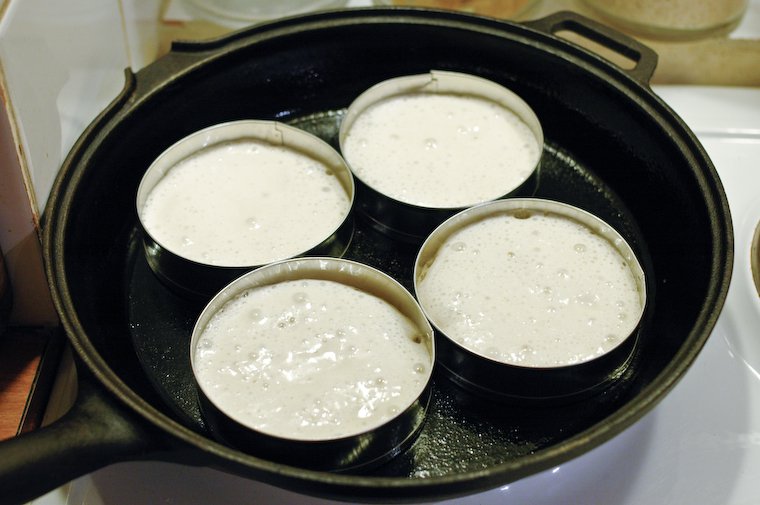


Notes
- A "100%" starter is fed an equal weight of flour and water at every feeding. To learn more about starters, please refer to my post on natural starter bread.
- If you have more starter to use up, mix the batter in 1-cup batches anyway, as written. The batter cooks best just after the addition of the baking soda, so a larger amount won't yield as good a result.
- Adapted from instructions found on the King Arthur Flour website.




